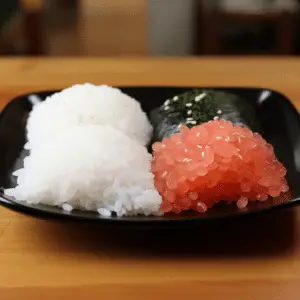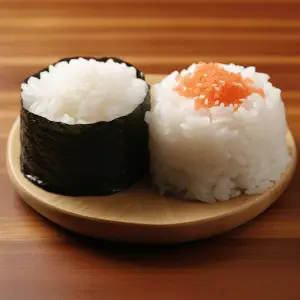
Sushi Rice vs White Rice: A Comparative Guide
The choice between white rice and sushi rice is a personal preference. Both have their uses in the kitchen, with white rice being more common for everyday cooking and sushi rice used for preparing complex dishes.
However, the differences between these types of rice can be quite confusing. Fortunately, we have taken the time to research both varieties, compare each type and come up with understandable information. Keep reading to learn more.

To Sushi Rice Vs White Rice: Overview
Sushi Rice
The Sushi rice is the base of all sushi dishes. It has a firm texture, with a toasted, nutty flavor and a chewy bite that gives it an appealing mouthfeel.
Sushi rice is made from short-grain white rice (the same kind used for risotto). The only difference between sushi rice and other varieties is that it has been soaked in water before cooking to soften it.
Additionally, this process removes some of its natural starch and makes it easier to handle when forming sushi rolls or making nigiri. It works well in many applications, including salads, stir-fries, and desserts. However, the key to making good sushi rice is using the correct proportions of water and rice.
Typically, Sushi consists of sticky glutinous rice that has been polished to remove its outer bran layer and then balled by hand. The ball is then steamed in a special steamer until it puffs up and rounds like the rest of the cooked rice.
Yet, the rice is not cooked but steamed, retaining its rounded shape.
White Rice
The White rice is refined rice that has been stripped of its bran and germ, resulting in a thinner texture and milder flavor than brown rice. To White rice is also called polished, parboiled, or semi-moist paddy rice because. It has been processed to remove the grain’s outer layers. It’s a staple food in many parts of Asia, particularly Japan.
White rice is made from varieties of long-grain white rice, such as Basmati and Jasmine. The name “white” refers to the color of the endosperm, which is removed during milling. White rice tends to be more refined than brown rice; they have a lower starch content, higher amylose content (which makes them softer), and less protein than their brown counterparts.
As a result, they’re usually cooked with less water but longer at higher temperatures than their brown counterparts. They usually contain low fiber content, so they may prove difficult to digest and completely absorb in the body.
Similarly, white rice doesn’t provide any nutritional value beyond simple carbohydrates, which are processed by the body into glucose shortly after consumption. So your body will continue to store them as fat, piling more health complications.
Similarities Between Sushi and White Rice
There are many similarities between Sushi and white rice. White rice is a staple food in the Western world, and Sushi is one of its most popular forms, especially in Japan. Both foods have been around for thousands of years, although they have also undergone major transformations in their histories.
Both dishes are low in fat. They can be served as part of a healthy diet with little fat or cholesterol. So they are suitable for those who want to lose weight and maintain a healthy lifestyle.
In Japan, many people eat Sushi every day—it is considered a healthy lifestyle because. It contains essential vitamins and minerals like vitamin B1 and B2. Similarly, white rice is also consumed daily by many people in Japan since it provides essential nutrients like iron, magnesium, and phosphorus.
Both can be prepared in different forms. For instance, Sushi may be made differently depending on its origin. For instance, it can be rolls, nigiri (the word means “pressed”), maki (a Japanese word meaning “rolled”), and sashimi (raw fish).
The same is also true with white rice. You can prepare it in different ways. For example, you might use brown rice instead of white rice in your risotto recipe or black-eyed peas instead of brown rice for your pilaf recipe.
Difference Between Sushi and White Rice
Sushi is the Japanese word for vinegared rice. It has been a part of Japanese cuisine since ancient times and has evolved into one of the most popular foods in Japan today. Sushi is usually made from rice and other ingredients, including fish, seafood, vegetables, and sometimes meat. It’s usually served with soy sauce as a dipping sauce.
Sushi tastes similar to plain white rice because both are made from the same type of grain – short-grain brown rice (Sushi) or long-grain brown rice (white). However, there are subtle differences between the two:
The main difference between the two kinds of rice is texture. Sushi rice is much stickier than white rice. It is sticky because of the vinegar used in making it. Plus, the amount of moisture in it also makes it sticky.
White rice has a very dry consistency compared to sushi rice. It does not have added ingredients like vinegar or sugar that would make it sticky like some other types of rice do. So it has a normal consistency when cooked and does not stick together as Sushi.
Sushi is not just a type of food but also an art form
It consists of many different types of fish and other ingredients that all work together. To create an interesting and beautiful dish. In contrast, white rice is cooked and served with little effort.
Ultimately, Sushi is more expensive than white rice since it requires more labor to prepare than other types of food such as bread or hamburgers. Also, it takes longer for Sushi to get from its raw state to its cooked state than. White rice to go from raw to cooked because of the many steps involved in preparing Sushi correctly.

Bottom Line
If you enjoy Sushi’s delicacy, you will likely favor Sushi Rice over ordinary White Rice. Most Japanese people would agree that the texture and added flavor of Sushi rice is one of the keys to making great Sushi. There are so many different types of Japanese rice, but for Sushi, Sushi Rice is best.